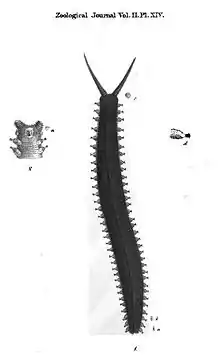Peripatus juliformis
Peripatus juliformis is a species of velvet worm in the Peripatidae family.[1] Females of this species have 33 or 34 pairs of legs; males have 29 or 30.[2] The type locality is on Saint Vincent Island.
| Peripatus juliformis | |
|---|---|
 | |
| Original illustration from Guilding, L. (1826) Mollusca Caribbaeana. Zoological Journal 2: plate XIV. | |
| Scientific classification | |
| Kingdom: | Animalia |
| Phylum: | Onychophora |
| Class: | Udeonychophora |
| Order: | Euonychophora |
| Family: | Peripatidae |
| Genus: | Peripatus |
| Species: | P. juliformis |
| Binomial name | |
| Peripatus juliformis Guilding, 1826 | |
This species became the first velvet worm known to science when Guilding described it in 1826. He thought it was an unusual type of slug, and included it along with his Caribbean mollusks.[3] He named this genus Peripatus (1826). He included an excellent watercolor painting of the specimen, and a mention of the defensive mechanism of sticky liquid squirts. A translation into English from Guilding's description, originally written in Latin, shows how he first classified the specimen in the Class Moluska, and how astonished he was for discovering a new species.[4] The specific epithet juliformis is a Latinisation of juliform, a botanial term meaning catkin-like.
References
- Oliveira, I.; Hering, L. & Mayer, G. "Updated Onychophora checklist". Onychophora Website. Retrieved 24 November 2016.
- Monge-Nájera, Julián (1994). "Reproductive trends, habitat type and body characteristcs in velvet worms (Onychophora)". Revista de Biología Tropical: 611–622. ISSN 2215-2075.
- Guilding, L. (1826). "Mollusca Caribbeana -- An Account of a New Genus of Mollusca". Zoological Journal. 2: 443–444 – via Biodiversity Heritage Library.
- Monge, J. (2019). " I, astonished, discovered by chance the only specimen”: the first velvet worm (Onychophora). Blog RBT. Retrieved from: https://revistas.ucr.ac.cr/index.php/rbt/article/view/39056/39793